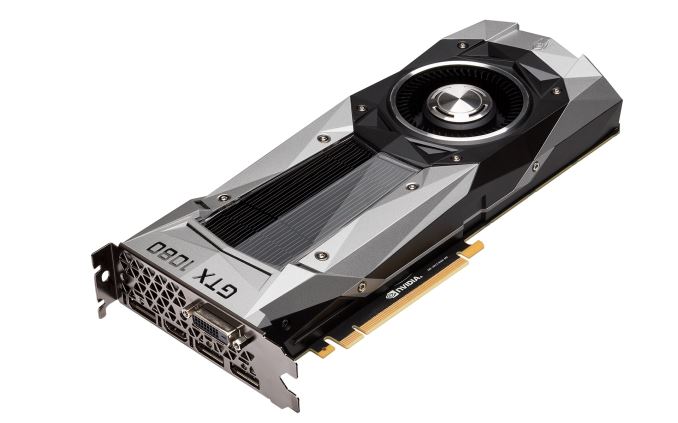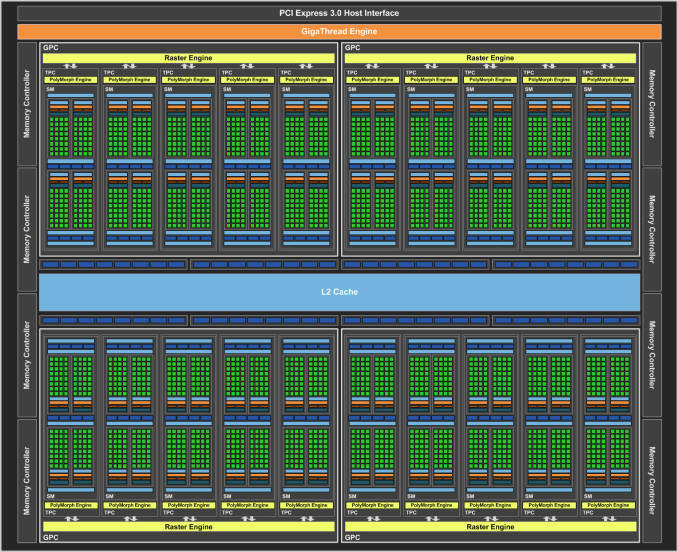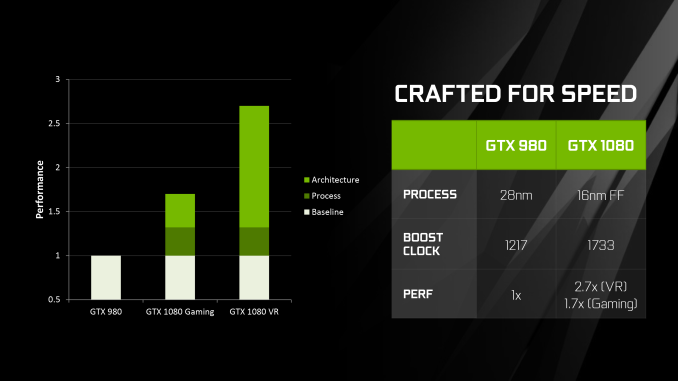The NVIDIA GeForce GTX 1080 Preview: A Look at What's to Come
by Ryan Smith on May 17, 2016 9:00 AM EST
Earlier this month NVIDIA announced their latest generation flagship GeForce card, the GeForce GTX 1080. Based on their new Pascal architecture and built on TSMC’s 16nm FinFET process, the GTX 1080 is being launched as the first 16nm/14nm-based video card, and in time-honored fashion NVIDIA is starting at the high-end. The end result is that the GTX 1080 will be setting the new high mark for single-GPU performance.
Unlike past launches, NVIDIA is stretching out the launch of the GTX 1080 a bit more. After previously announcing it back on May 6th, the company is lifting their performance and architecture embargo today. Gamers however won’t be able to get their hands on the card until the 27th – next Friday – with pre-order sales starting this Friday. It is virtually guaranteed that the first batch of cards will sell out, but potential buyers will have a few days to mull over the data and decide if they want to throw down $699 for one of the first Founders Edition cards.
As for the AnandTech review, as I’ve only had a few days to work on the article, I’m going to hold it back rather than rush it out as a less thorough article. In the meantime however, as I know everyone is eager to see our take on performance, I wanted to take a quick look at the card and the numbers as a preview of what’s to come. Furthermore the entire performance dataset has been made available in the new GPU 2016 section of AnandTech Bench, for anyone who wants to see results at additional resolutions and settings.
Architecture
| NVIDIA GPU Specification Comparison | ||||||
| GTX 1080 | GTX 980 Ti | GTX 980 | GTX 780 | |||
| CUDA Cores | 2560 | 2816 | 2048 | 2304 | ||
| Texture Units | 160 | 176 | 128 | 192 | ||
| ROPs | 64 | 96 | 64 | 48 | ||
| Core Clock | 1607MHz | 1000MHz | 1126MHz | 863MHz | ||
| Boost Clock | 1733MHz | 1075MHz | 1216MHz | 900Mhz | ||
| TFLOPs (FMA) | 9 TFLOPs | 6 TFLOPs | 5 TFLOPs | 4.1 TFLOPs | ||
| Memory Clock | 10Gbps GDDR5X | 7Gbps GDDR5 | 7Gbps GDDR5 | 6Gbps GDDR5 | ||
| Memory Bus Width | 256-bit | 384-bit | 256-bit | 384-bit | ||
| VRAM | 8GB | 6GB | 4GB | 3GB | ||
| FP64 | 1/32 | 1/32 | 1/32 FP32 | 1/24 FP32 | ||
| TDP | 180W | 250W | 165W | 250W | ||
| GPU | GP104 | GM200 | GM204 | GK110 | ||
| Transistor Count | 7.2B | 8B | 5.2B | 7.1B | ||
| Manufacturing Process | TSMC 16nm | TSMC 28nm | TSMC 28nm | TSMC 28nm | ||
| Launch Date | 05/27/2016 | 06/01/2015 | 09/18/2014 | 05/23/2013 | ||
| Launch Price | MSRP: $599 Founders $699 |
$649 | $549 | $649 | ||
While I’ll get into architecture in much greater detail in the full article, at a high level the Pascal architecture (as implemented in GP104) is a mix of old and new; it’s not a revolution, but it’s an important refinement. Maxwell as an architecture was very successful for NVIDIA both at the consumer level and the professional level, and for the consumer iterations of Pascal, NVIDIA has not made any radical changes. The basic throughput of the architecture has not changed – the ALUs, texture units, ROPs, and caches all perform similar to how they did in GM2xx.
Consequently the performance aspects of consumer Pascal – we’ll ignore GP100 for the moment – are pretty easy to understand. NVIDIA’s focus on this generation has been on pouring on the clockspeed to push total compute throughput to 9 TFLOPs, and updating their memory subsystem to feed the beast that is GP104.
On the clockspeed front, a great deal of the gains come from the move to 16nm FinFET. The smaller process allows NVIDIA to design a 7.2B transistor chip at just 314mm2, while the use of FinFET transistors, though ultimately outright necessary for a process this small to avoid debilitating leakage, has a significant benefit to power consumption and the clockspeeds NVIDIA can get away with at practical levels of power consumption. To that end NVIDIA has sort of run with the idea of boosting clockspeeds, and relative to Maxwell they have done additional work at the chip design level to allow for higher clockspeeds at the necessary critical paths. All of this is coupled with energy efficiency optimizations at both the process and architectural level, in order to allow NVIDIA to hit these clockspeeds without blowing GTX 1080’s power budget.
Meanwhile to feed GTX 1080, NVIDIA has made a pair of important changes to improve their effective memory bandwidth. The first of these is the inclusion of faster GDDR5X memory, which as implemented on GTX 1080 is capable of reaching 10Gb/sec/pin, a significant 43% jump in theoretical bandwidth over the 7Gb/sec/pin speeds offered by traditional GDDR5 on last-generation Maxwell products. Coupled with this is the latest iteration of NVIDIA’s delta color compression technology – now on its fourth generation – which sees NVIDIA once again expanding their pattern library to better compress frame buffers and render targets. NVIDIA’s figures put the effective memory bandwidth gain at 20%, or a roughly 17% reduction in memory bandwidth used thanks to the newer compression methods.
As for features included, we’ll touch upon that in a lot more detail in the full review. But while Pascal is not a massive overhaul of NVIDIA’s architecture, it’s not without its own feature additions. Pascal gains the ability to pre-empt graphics operations at the pixel (thread) level and compute operations at the instruction level, allowing for much faster context switching. And on the graphics side of matters, the architecture introduces a new geometry projection ability – Simultaneous Multi-Projection – and as a more minor update, gets bumped up to Conservative Rasterization Tier 2.
Looking at the raw specifications then, GTX 1080 does not disappoint. Though we’re looking at fewer CUDA cores than the GM200 based GTX 980 Ti or Titan, NVIDIA’s significant focus on clockspeed means that GP104’s 2560 CUDA cores are far more performant than a simple core count would suggest. The base clockspeed of 1607MHz is some 42% higher than GTX 980 (and 60% higher than GTX 980 Ti), and the 1733MHz boost clockspeed is a similar gain. On paper, GTX 1080 is set to offer 78% better performance than GTX 980, and 47% better performance than GTX 980 Ti. The real world gains are, of course, not quite this great, but they’re also relatively close to these numbers at times.















262 Comments
View All Comments
Mlok - Thursday, May 19, 2016 - link
I've seen this alredy in tables in some other articles, so got to ask: since when is memory clock measured in Gbps? Doesnť make any sense to me, one would say clock is measured Hz, while Gigabits per second goes for bandwidth, hm?nick.evanson - Monday, May 23, 2016 - link
The memory clock isn't used for determining processing capabilities, as such, unlike with the GPU core itself, where it is used to determine peak FLOPS, pixel read/writes, etc. In the case of memory, all that matters (on face value) is how much data can be transferred to and from it and this is indicated by the Gbps - the "memory" can shift, say, 7 Gbits per second and because the "bus" is 256 bit wide, the total bandwidth is 1792 Gb/s (or 224 GB/s). So one might ask, why not just quote the bandwidth? This used to be the case, simply because bus width across different vendors and SKUs were remarkably similar compared to the broad variation one sees now.mikable - Thursday, May 19, 2016 - link
When's the MXM version coming out?lashek37 - Friday, May 20, 2016 - link
Has Soon As AMD comes out with their card. Nvidia will unleash the GTX980T.I.😂 Nvidia do this every year lol.Ranger1065 - Monday, May 23, 2016 - link
Anandtech is a good site that I have visited frequently since the early 2000s to quench an insatiable appetite for primarily CPU&GPU reviews. However there are now sites out there, one in particular, that are doing it better than Anandtech and consequently I don't spend so much time here.It is now almost a week since the embargo on GTX1080 reviews was lifted and previews aside, there is still a deafening silence from Anandtech. Yes the apologists will argue Anandtech does a deeper review, give them time and all that but seriously when your review is this late, it begins to look like incompetence. Or perhaps you consider your reviews to be elitist, the holy grail among tech websites and that therefore any delay is acceptable? What pressing projects are the GPU staff working on that could explain this state of affairs?
GET IT TOGETHER ANANDTECH YOU USED TO BE BETTER!
vacavalier - Monday, May 23, 2016 - link
If you own a 980 Ti... No need to get overly excited/worried about upgrading to this particular GPU, unless you just have to have the "latest and "greatest". Initial testing was done vs. the GTX 980? Rather odd and goes back to my initial statement.On the other hand, if running a 970 (or below) and 980 (apparently, according to NV) or 700 series GPU, this presents a very good upgrade-path.
Time will tell what will happen with that MSRP however, once vendors start doing their add-on's; cooling solutions, factory OC's, software bundles, etc...
lakedude - Tuesday, May 24, 2016 - link
I'm shocked every day that goes by that no GTX 1080 review exists yet. The move to 14-16nm has got to be on of the most highly anticipated in recent history an all we have is a preview?? BTW I don't need a tech site to price check the 6700 CPU for me, i can do that myself.Bang4BuckPC Gamer - Wednesday, May 25, 2016 - link
I thought the main purpose of a review was to give a potential customer an idea of what to expect, and some expert analysis, and some honest judgement on a product and whether or not it's worth your money as a consumer. The card releases in two days and if you don't have a review out by then what is the bleeding pointvzortex - Wednesday, May 25, 2016 - link
"later this week" was over last week. No review?tarqsharq - Wednesday, May 25, 2016 - link
I'm kind of expecting it tomorrow, the day before the product gets into people's hands. I know pre-orders already started, but those people were probably going to buy regardless.